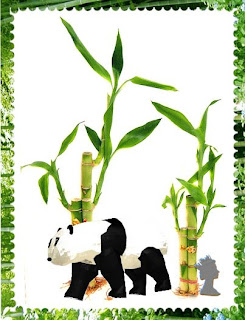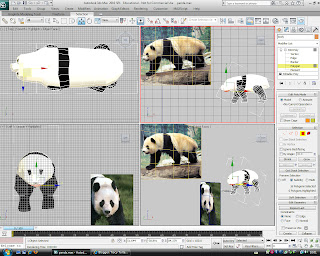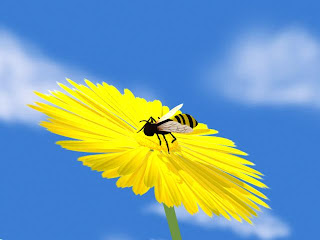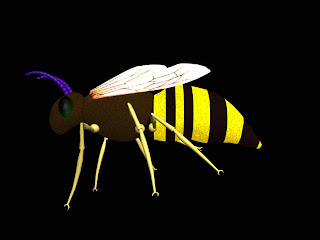 The final stamp was produced the same way as the others, except two different images were used for the outer and inner background.
The final stamp was produced the same way as the others, except two different images were used for the outer and inner background.Tuesday, 12 January 2010
Panda stamp
 The final stamp was produced the same way as the others, except two different images were used for the outer and inner background.
The final stamp was produced the same way as the others, except two different images were used for the outer and inner background.Monday, 11 January 2010
Finishing touches
Sunday, 10 January 2010
And finally......................................
back to the panda.

Using sub object mode I applied black and white material to the polygons. The eye area was inset then beveled inwards slightly and a sphere positioned in the socket and a black glossy texture with slight specularity applied. For the nose I extruded some polygons and split the edge of some polygons for the mouth. However on a quick render it shows that the head still needs a lot of work.

Thursday, 7 January 2010
stamp design
bee and flower
 The material on the flower was completely redone as there were white marks along the edges of the petals, which altering the co-ordinates did not seem to be overly effective. I then moved the bee onto the flower. For the background I created a sky image in photoshop, made by filling it with a sky blue then using a large soft brush with an off white colour, lowered opacity and flow to craw out the clouds. This sky image was then mapped onto a plane using the material editor. Finally I added a spotligfht to the scene and after many faioed attempts eventually managed to place it so that the beee cast a shadow over the flower.
The material on the flower was completely redone as there were white marks along the edges of the petals, which altering the co-ordinates did not seem to be overly effective. I then moved the bee onto the flower. For the background I created a sky image in photoshop, made by filling it with a sky blue then using a large soft brush with an off white colour, lowered opacity and flow to craw out the clouds. This sky image was then mapped onto a plane using the material editor. Finally I added a spotligfht to the scene and after many faioed attempts eventually managed to place it so that the beee cast a shadow over the flower.Tail end
 The individual polygons of the stripes were selected and an ID given to them. These were then coloured using a cellular bump map as I found this gave the best effect. The same dark material was added to the body and head sections. I then used the turbosmooth modifier before the hair and fur modifier. I found that by lowering the hair count and length it acheived a reasonable result. I then added the wings by cutting out the wings from an image in photoshop, creating a black and white outline of it and using the material editor to apply the images onto a plane, as in the leaf tutorial.
The individual polygons of the stripes were selected and an ID given to them. These were then coloured using a cellular bump map as I found this gave the best effect. The same dark material was added to the body and head sections. I then used the turbosmooth modifier before the hair and fur modifier. I found that by lowering the hair count and length it acheived a reasonable result. I then added the wings by cutting out the wings from an image in photoshop, creating a black and white outline of it and using the material editor to apply the images onto a plane, as in the leaf tutorial.The antennae were created by cutting the top and bottom off a sphere then using the array tool to replicate it. The taper and bend modifiers were then applied before being copied and moved into place. Material was also added to the eyes, legs and antennae before being exported as an object and imported into the flower image.

stamp design
 I created the stamp by placing the final rendered image onto the bottom layerand using the clolne brush to remove the plant from the edge. I then drew out a white rectangle on another layer. Then on a third layer I placed the final image in the centre. I then selected the layer with the rectangle and used a small eraser brush to stamp out the sections on two of the sides. Each of these sides were then copied and rotated and used to replace the oppsite sides, which were selected using the rectangle selection tool and deleted. The queen's head was then placed in the corner and originally coloured bronze before adding the lens flare and emboss filters.
I created the stamp by placing the final rendered image onto the bottom layerand using the clolne brush to remove the plant from the edge. I then drew out a white rectangle on another layer. Then on a third layer I placed the final image in the centre. I then selected the layer with the rectangle and used a small eraser brush to stamp out the sections on two of the sides. Each of these sides were then copied and rotated and used to replace the oppsite sides, which were selected using the rectangle selection tool and deleted. The queen's head was then placed in the corner and originally coloured bronze before adding the lens flare and emboss filters.
swim fishy swim
 Finally I added a fog effect in the render set up and coloured it a deep sea green/blue. The fish model was cloned as a copy, which was then rotated and moved further back in the scene. To create the plant I used a cylinder upon which I used the bend and taper modifier. This was then cloned several times using the array tool, then the whole section was selected and copied. I then moved these around the scene and changed the bend and taper settings on individual ones to give a more random look.
Finally I added a fog effect in the render set up and coloured it a deep sea green/blue. The fish model was cloned as a copy, which was then rotated and moved further back in the scene. To create the plant I used a cylinder upon which I used the bend and taper modifier. This was then cloned several times using the array tool, then the whole section was selected and copied. I then moved these around the scene and changed the bend and taper settings on individual ones to give a more random look.Lighting underwater scene

I added a direct spotlight and two omni lights. Using the tools>light lister to access all three lights I reduced the multiplier on the omni lights and ticked box to include shadows. The decay rate was changed to inverse and the start point lowered on the spotlight as I found this gave a better effect. The spotlight was also modified by adding volume light to the atmospheres and effects and a water texture image added to the projector map to create a caustic effect. The light colour was changed to a light blue, placed at an angle from above the scene and enlarged to cover a greater area.
Underwater scene
 To give the fish an environment more suited to it's needs I created an undersea scene. I placed a large flat cube at the base of the scene and added a noise modifier before adding a sand texture, which I created in photoshop by choosing a light and dark sandy colour with the render >clouds filter, followed by the noise filter and the the grain texturer
To give the fish an environment more suited to it's needs I created an undersea scene. I placed a large flat cube at the base of the scene and added a noise modifier before adding a sand texture, which I created in photoshop by choosing a light and dark sandy colour with the render >clouds filter, followed by the noise filter and the the grain texturer .
.Gone fishing
 After spending probably way too long trying to resolve the issues I encountered with the fish I eventually gave up and started again from scratch. This time I was able to go through the modelling stages much quicker, but decided not to adjust the polygons to create the stripes instead just making it one colour with the additon of specular colour and changing the specular and glossiness levels in the material editor. A slightly glossy black material with specular highlights were added to the eyes.
After spending probably way too long trying to resolve the issues I encountered with the fish I eventually gave up and started again from scratch. This time I was able to go through the modelling stages much quicker, but decided not to adjust the polygons to create the stripes instead just making it one colour with the additon of specular colour and changing the specular and glossiness levels in the material editor. A slightly glossy black material with specular highlights were added to the eyes.
Subscribe to:
Comments (Atom)




